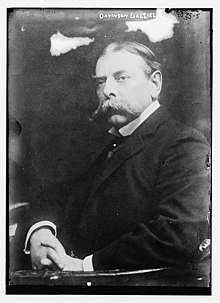Davison Dalziel, 1st Baron Dalziel of Wooler
Davison Alexander Dalziel, 1st Baron Dalziel of Wooler (17 October 1852 – 18 April 1928), known as Sir Davison Dalziel, Bt, between 1919 and 1928, was a British newspaper owner and Conservative Party politician. He sat in the House of Commons between 1910 and 1927, before a brief period in the House of Lords. He was the founder of Dalziel's News Agency.[1]

Life
Dalziel was born in London, the son of Davison Octavian Dalziel and Helen Gaultier.[2]
Dalziel moved to New South Wales to work as a journalist for the Sydney Echo. He also spent several years in the United States in the management department of various newspapers, and when he returned to England in 1890 he set up his own business, Dalziel's News Agency. With partners he bought controlling stakes in The Standard and Evening Standard newspapers in 1910. He sold off his newspaper interests to further his work in the cab industry, setting up several companies including General Motor Cab Company Ltd, the Pullman Car Company and the International Sleeping Car Share Trust Ltd.[3]
At the January 1910 general election he was elected as the Member of Parliament (MP) for Brixton,[4] holding the seat until his defeat at the 1923 general election.[5] He had been created a baronet in 1919.[6]
He regained the Brixton seat in 1924,[5] and held it for a further three years until his resignation from the House of Commons on 9 June 1927, by taking the Chiltern Hundreds[7] In 1927 he was raised to the peerage as Baron Dalziel of Wooler, of Wooler in the County of Northumberland.[8]
He is buried in the eastern section of Highgate Cemetery in north London, close to the main entrance.
Personal life
Lord Dalziel of Wooler married Harriet, daughter of J. G. Dunning, in 1876. He died on 18 April 1928, aged 75, when the baronetcy and barony became extinct.[2] In his will, which was only 140 words long, he left over £2,250,000 to Lady Dalziel, who herself died on 7 December 1938.[9]
References
- "Person Page". thepeerage.com.
- "Person Page". thepeerage.com.
- "Oxford DNB article: Dalziel, Davison Alexander, Baron Dalziel of Wooler". Oxford University Press. 2004. Retrieved 2 January 2009.
- Craig, F. W. S. (1989) [1974]. British parliamentary election results 1885–1918 (2nd ed.). Chichester: Parliamentary Research Services. p. 29. ISBN 0-900178-27-2.
- Craig, F. W. S. (1983) [1969]. British parliamentary election results 1918–1949 (3rd ed.). Chichester: Parliamentary Research Services. p. 33. ISBN 0-900178-06-X.
- "No. 31427". The London Gazette. 1 July 1919. p. 8221.
- Department of Information Services (14 January 2010). "Appointments to the Chiltern Hundreds and Manor of Northstead Stewardships since 1850" (PDF). House of Commons Library. Archived from the original (PDF) on 6 February 2011. Retrieved 13 August 2010.
- "No. 33292". The London Gazette. 8 July 1927. p. 4406.
- "Lady Dalziel of Wooler Dead". Western Daily Press. 8 December 1938. Retrieved 25 December 2015 – via British Newspaper Archive.
External links
| Wikisource has original works written by or about: Davison Dalziel, 1st Baron Dalziel of Wooler |
- Hansard 1803–2005: contributions in Parliament by Davison Dalziel
| Parliament of the United Kingdom | ||
|---|---|---|
| Preceded by Joel Seaverns |
Member of Parliament for Brixton January 1910 – 1923 |
Succeeded by Frederick Joseph Laverack |
| Preceded by Frederick Joseph Laverack |
Member of Parliament for Brixton 1924 – 1927 |
Succeeded by Nigel Colman |
| Peerage of the United Kingdom | ||
| New creation | Baron Dalziel of Wooler 1927–1928 |
Extinct |
| Baronetage of the United Kingdom | ||
| New creation | Baronet (of Grosvenor Place) 1919–1928 |
Extinct |